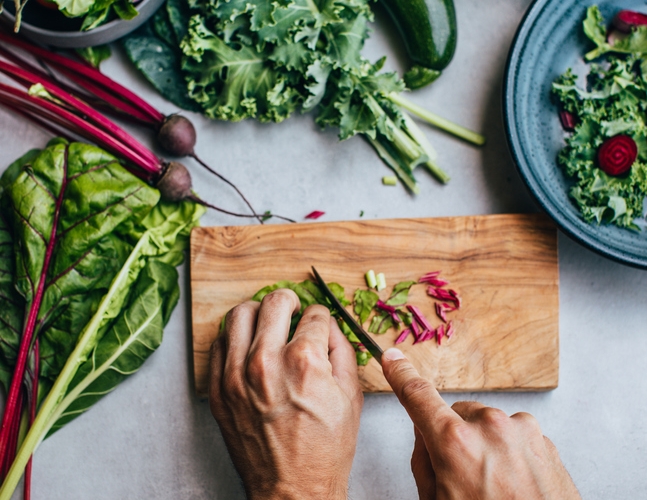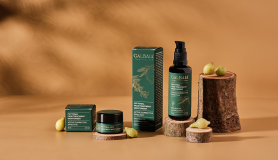Looking out at our vegetable plot at this time of year, I sometimes feel a little despondent. The splendour and lushness of the autumn months is over, and the whole garden seems to be in a deep slumber. This probably says more about the effort I’ve put in over the last few months – I certainly didn’t get on top of any winter sowings – but it is a quieter time of year in terms of produce. So what is in season and how can we make the most of what pops up in our veg boxes?
Kale
A kind of cabbage, kale is packed with nutrients. Vitamins A, C and K, iron and antioxidants all feature in this power-packed vegetable. I like it sautéed in sesame oil with grated ginger, garlic and fresh chilli – yum!
Kale, Lentil and Pepper Stir Fry (from www.abelandcole.co.uk)
350 g kale
1 pepper
1 onion
2.5 cm piece root ginger
2 tablespoons sunflower oil
2 tablespoons sesame oil
1 garlic clove peeled and crushed
400 g lentils, ready to use
2 tablespoons sesame seeds, toasted
Sauce:
1 teaspoon dark soy sauce
1 tablespoons chilli sauce
3 tablespoons water
1 teaspoon lime juice
Remove the stalks from the kale and discard. Shred the leaves. Halve, core and de-seed the pepper. Peel and thinly slice the onion. Peel and grate the ginger. To make the sauce, mix all the ingredients together in a small bowl. Blanche the kale and then drain. Heat the sunflower and sesame oils in a wok or deep frying pan. When hot, stir-fry the pepper, onion, ginger and garlic over a high heat for 3 minutes. Add the kale together with the lentils and sauce. Stir well, cover and cook over low heat for 3-4 minute until the vegetables are tender. Scatter over the sesame seeds and serve at once.
Beetroot
Beetroot is a wonderfully versatile vegetable – sweet enough to use for baking and lovely grated raw into salads. It has one of the highest sugar contents – 10% - of any vegetable. A source of folic acid, containing potassium, magnesium and iron as well as vitamins A, B6 and C, beetroot is also great for boosting stamina and making muscles more efficient.
Borshch recipe (from www.greenchronicle.com)
Ingredients
2 large uncooked beetroots (about 1lb)
1 onion
1 leek
1 carrot
1 turnip
1 large potato
1 stick of celery
2 pints strong chicken stock
1 bay leaf
1 tablespoon tomato puree
juice of half a lemon
2 tablespoon finely chopped parsley
1 level teaspoon caster/superfine sugar
seasoning
chives for garnish
1/4 pint sour cream
Method
- Peel and dice the beetroot.
- Prepare all the other vegetables and chop finely.
- Put them all into a large saucepan and cover with the stock.
- Add the bay leaf and parsley and season well.
- Bring to the boil and then cover and simmer for 30 minutes.
- Add the sugar, lemon juice, and tomato puree to the soup and continue to simmer for another 30 minutes or until the vegetables are cooked.
- Allow to cool and blend in blender.
- Re-heat thoroughly and add the sour cream just before serving with a sprinkling of chopped chives.
Yvonne Bishop-Weston’s Power Salad (from www.lovebeetroot.co.uk)
What you’ll need:
For the dressing:
50g natural organic yogurt or soya yogurt
4g (1 teaspoon) fresh dill - finely chopped
10g (1 teaspoon) horseradish
2 tablespoons fresh lemon juice
For the salad:
2 Omega-3 eggs hard boiled or poached
80g cooked beetroot - chopped
60g yellow pepper - chopped
40g (2 tablespoons) sprouted beans and lentils (supermarket mix)
2 handfuls (40g) of mixed leaves - washed and drained
6 walnut halves
Rock salt to taste
Serve with:
1 slice of rye toast topped with half a small avocado black pepper and lemon juice or with houmous or tahini
Chestnuts
Chestnuts are the large edible seeds of the sweet chestnut tree. Delicious roasted and eaten alone, they also make a fantastic accompaniment to many vegetables and can be used in desserts for a rich, smooth flavour.
Chestnut pesto recipe (from www.chestnutrecipes.co.uk)
The smooth, earthy flavour of the chestnuts makes for a delicious pesto when combined with basil, garlic and extra-virgin olive oil. Smear it onto paninis, serve it over pasta or use it to stuff chicken.
Ingredients:
100ml rapeseed oil
50ml extra-virgin olive oil
100g roasted chestnuts, peeled
50g finely grated parmesan
2 garlic cloves
Small handful each picked mint leaves, basil leaves and parsley leaves
Directions:
Place the chestnuts into a blender and pulse until finely chopped.
Add the mint leaves, basil leaves, parsley leaves parmesan and garlic. Blend again until finely chopped.
Whilst the blender is switched on, gradually pour in the oil until it is all in the blender. Blend for a little longer until you have a thinned, slightly runny pesto.
Pesto will keep in the fridge in an airtight jar for up to a couple of weeks. Recipe will serves 6-8.
Brussels sprouts
Brussels sprouts are a good source of vitamins A and C and iron, potassium and fibre. They tend to divide people into those who love ‘em and those who hate ‘em, but cooked in the right way they make a delicious addition to many dishes.
Creamy Fettuccine with Brussels sprouts and mushrooms (from www.eatingwell.com)
Ingredients
12 ounces whole-wheat fettuccine
1 tablespoon extra-virgin olive oil
4 cups sliced mixed mushrooms, such as cremini, oyster and/or shiitake
4 cups thinly sliced Brussels sprouts
1 tablespoon minced garlic
1/2 cup dry sherry, or 2 tablespoons sherry vinegar
2 cups low-fat milk
2 tablespoons all-purpose flour
1/2 teaspoon salt
1/2 teaspoon freshly ground pepper
1 cup finely shredded Asiago cheese, plus more for garnish
Preparation
Cook pasta in a large pot of boiling water until tender, 8 to 10 minutes. Drain, return to the pot and set aside.
Meanwhile, heat oil in a large skillet over medium heat. Add mushrooms and Brussels sprouts and cook, stirring often, until the mushrooms release their liquid, 8 to 10 minutes. Add garlic and cook, stirring, until fragrant, about 1 minute. Add sherry (or vinegar), scraping up any brown bits; bring to a boil and cook, stirring, until almost evaporated, 10 seconds (if using vinegar) or about 1 minute (if using sherry).
Whisk milk and flour in a bowl; add to the skillet with salt and pepper. Cook, stirring, until the sauce bubbles and thickens, about 2 minutes. Stir in Asiago until melted. Add the sauce to the pasta; gently toss. Serve with more cheese, if desired.
Carrots
Probably one of the most versatile of all vegetables, carrots are good in savoury or sweet dishes, raw or cooked. They can be enjoyed lightly steamed with a bit of butter and some fresh herbs (heaven!) or they can be eaten straight out of the soil. The humble carrot really is pretty special and when you’ve tasted home-grown you won’t want those jumbo tasteless supermarket carrots any more.
Chinese Noodle and Carrot Salad (from www.carrotmuseum.co.uk)
6 medium carrots;
water;
9oz linguine style pasta;
3 tablespoons soya sauce;
3 tablespoons sesame oil;
2 tablespoons grated pared ginger root
2 tablespoons crushed garlic;
2 tablespoons sugar;
2 tablespoons toasted sesame seeds
8oz water chestnuts (drained, sliced);
4 medium onions (sliced);
1 teaspoon hot chilli oil
Method:
Trim and pare carrots, cut into thin, long diagonal slices. Add carrots to 2 pints of boiling water, return to boil and simmer for 5 minutes until tender. Drain and flush with warm water. Bring 2 further pints of water to boil in kettle. Cut bundle of noodles once or twice across to shorten. Slip noodles into boiling water and simmer for 2 minutes. Drain and rinse.
In bottom of a salad bowl combine soya sauce, sesame oil, garlic, sugar and sesame seeds. Mix to blend then add carrots, noodles, water chestnuts and onion. Toss well and add chilli oil to taste. Cover salad and chill at least 4 hours to let flavours develop.







